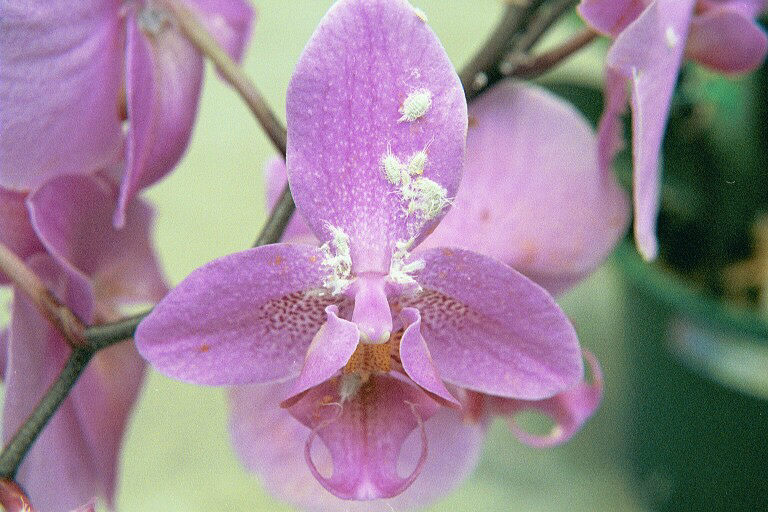 |
| What Pest Is That? MEALYBUGS |
| MEALYBUGS fit into the same category as aphids, that is the zoological order of Homoptera (pronounced �ho-MOP-ter-ah�). These critters can grow up to about 3 mm long & can also vary a little in appearance, with some species covered with fluffy wax while others have long tails of fluffy wax. Mealybugs are a pest that can affect both indoor and outdoor ornamentals & crops across the world, including your orchids. They are however, most active during the warmer, dryer weather. Small numbers of mealybugs are easily overlooked as they tend to wedge into crevices on plants, usually at the base of stems & in the leaf axils but after the first batch of eggs hatch, the infestation becomes very noticeable. As their numbers increase, mealybugs of all sizes can be found crawling around or feeding on all surfaces of the plant. Recognition The Females Female mealybugs are a soft oval insect without wings, and so, must be transported directly to or near to, the next host plant. They can travel short distances by crawling or the very young nymphs may be blown about by the wind or even the breeze created by the fan that you use to circulate the air around your orchids. Each female will usually lay between 200 & 600 eggs, which require about 10 days to hatch under normal summer conditions, & she will usually begin laying her eggs a few days after mating. These eggs are very very small but can be conspicuous on your plants because they are laid in a dense, fluffy, white mass of wax called the ovisac. When the eggs hatch, the very young nymphs are flat, oval and yellow, but as they get older, the nymphs tend to be covered with fluffy, white wax. After several weeks of feeding flat out, the nymphs will develop into adults. Some species of mealybugs can give birth to live young. The Males Male mealybugs are tiny, gnat like insects with two wings and long tails of white wax substance & are a much smaller creature than their womenfolk, with the mature females being about four times the length of the adult male. Mature males have a single pair of delicate, membranous wings which are held flat over the abdomen when at rest, and a pair of distinctive, elongated 'caudal filaments' posteriorly (meaning, long fluffy things stuck to their bums). The mature males lack functional mouth parts (ain�t that typical, the poor old male once again gets the raw end of the deal) and therefore does not feed. In the case of males, the final instar nymph (the nymph after it has hatched & had a bit of a feed & grown a bit of a waxy covering) spins a small silken cocoon which encloses the 'pseudopupa' & here completes its development into the winged male. Their pseudopupal cocoon is often hidden in a sheltered site, usually under the bark, and as the adult males are not active during the daytime, they will emerge in the early evening and are attracted by pheromones (sweaty armpits) of the mature females. The males usually do not survive long, only a day or two at most. Because male Mealybugs appear (if you are fortunate enough to see one) very small and delicate, one would think they would be very weak fliers. But in fact, they are very proficient at locating unmated females by following the pheromone plume emitted by the lady Mealybugs, & can travel vast distances. It would be reasonably safe to assume that the male Mealy Bug has only one thing on his mind! The Damage Mealybugs damage plants by inserting their threadlike mouthparts into any part of the plant and sucking out sap. They then excrete honeydew, a sweet, sticky liquid, similar to that of Aphids. Sooty mould often grows in the honeydew causing infested plants to blacken. The mealybugs, their ovisacs, honeydew and the resulting sooty moulds disfigure heavily infested plants. The honeydew can also encourage the presents of ants, as the honeydew is a favorite food source for them. Control Mealybugs are not easy to control. Because the eggs are enmeshed in the waxy fluffy ovisac, it is difficult to get a pesticide through to kill them. If an infestation is discovered early enough on a few cherished plants, the mealybugs may be removed by a cotton swab or small hobby type paintbrush dipped in alcohol (no, not your can of beer!), fingernail polish remover (that probably explains why I have never seen a Mealybug with nicely painted fingernails), or Meths. Keep an eye on the plants for a few weeks to make sure no mealybugs have been overlooked. If a large number of plants are infested, spray the plants thoroughly with one of the pesticide mixtures that are available at your local garden shop such as �Orthene�, �Shield� or a spraying oil used as recommended on the package. This treatment may have to be repeated two or more times at weekly intervals since new mealybugs hatch from egg masses which might have been missed by the spray. Remember the best prevention is to knock these guys on the head as soon as you spot them on your plants. |
 |
 |